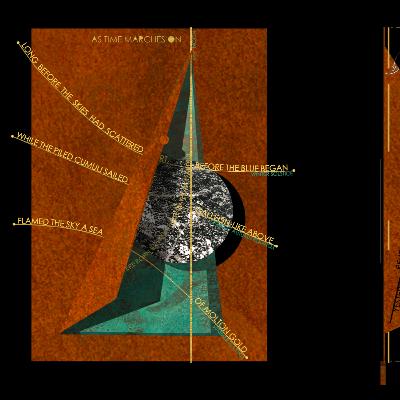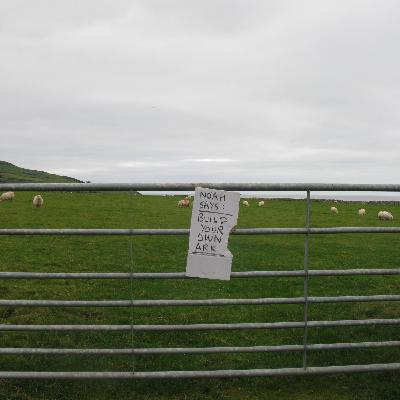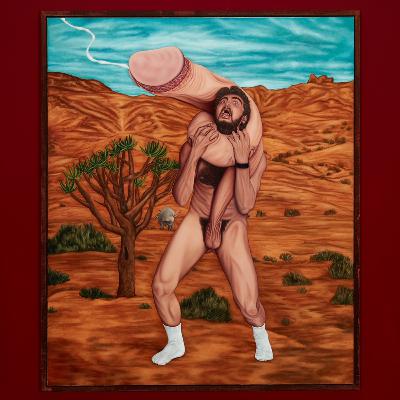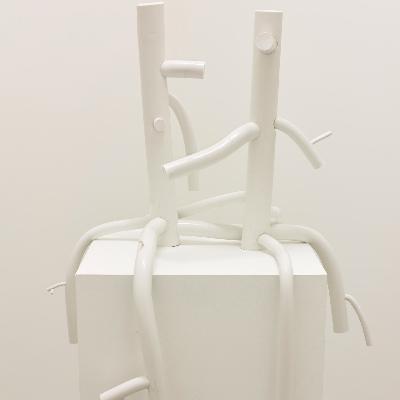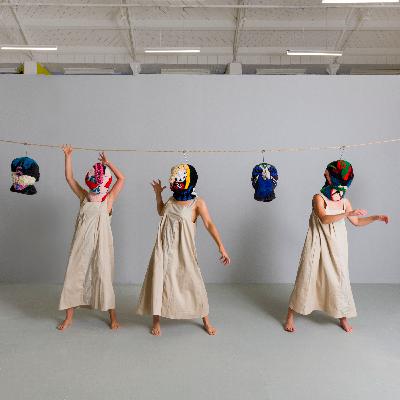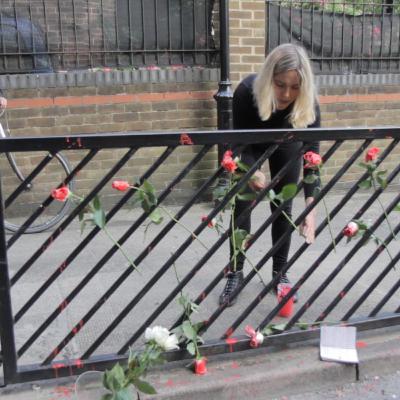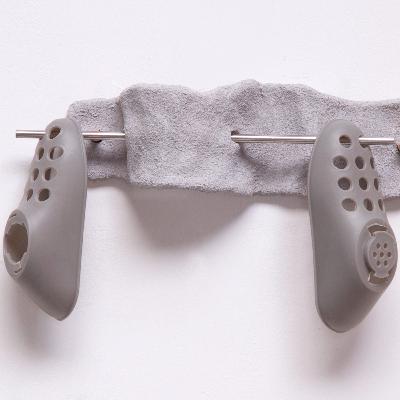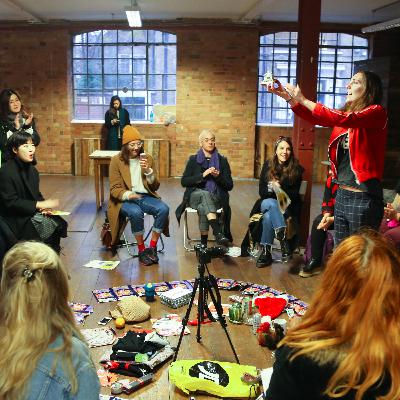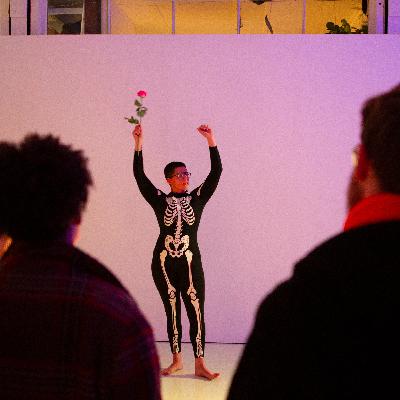Discover Chats with Artists in Lockdown
Chats with Artists in Lockdown

Chats with Artists in Lockdown
Author: Emma Cousin
Subscribed: 11Played: 204Subscribe
Share
© Emma Cousin
Description
Chats with Artists in Lockdown, is a Podcast of artists talking together. Discussing how the virus has impacted them and their work; what's been lost and what's been discovered. The conversation wanders between artist’s making and thinking and they share their strategies and experiences through this weird time.
35 Episodes
Reverse
Holly Graham and I talk about getting back on a bike, this risky changing time, maintaining a sense of urgency, productive fear and cautious anxiety, and working to a deadline and floundering. We talk about work that has been delayed or paused such as Holly's public commission in Coulsdon, a sundial, which Holly is reconnecting with in her mind and worrying if all the calculations will still work! We talk about her residency in Southwark Park and the possibilities of corresponding events shifting under distancing measures. We talk about Holly's writing, and she reads a passage from her piece for an anthology On Care commissioned by Sharon Kievland and Rebecca Jagoe. We talk about sugar, migration and movement of objects touching on Holly's Sweet and Swollen series and Christina Sharpe's metaphors of the wake and the hold. We talk about the sugar bowls at the V&A that became the focus on Sweet and Swollen, which depict enslaved labour and the product of that labour at the same time. We talk about using photographs, found and personal. Holly talks about attending to images and the potential reanimation of the in-betweens. We talk about the word shuddering. We talk about the side hustle, and her podcast episode of this name commissioned by TACO, and her band Don't Freak Out. We talk about house mates, weekly aims, and formalising time for care. We end on surprise at the toll that separation has taken and the need for people and touch.
Image:
Cane Hill sundial design. 2020.
Links:
Website: hollygraham.co.uk
Instagram: @hollycagraham
To Us It Just Looks Like A Lemon, residency at Southwark Park Galleries: https://southwarkparkgalleries.org/to-us-it-just-looks-like-a-lemon-research-online/
On Care anthology to be published in July: https://mabibliotheque.cargo.site/ANTHOLOGIES-COLLECTIONS-THE-CONCEIT-OF-THE-CONCEPTUAL-copy
TACO podcast: https://rtm.fm/shows/twang-achoo-clang-oooff/holly-graham/
Music:
Don’t Freak Out.Jealous Guy featuring Natasha Heliotis on lead vocals.
Tom James and I talk about being exhausted, kids, childcare, carving out 10 minute art time, chores, wiping and beard growing. Tom tells us about his forthcoming project, Absolute Beginners, a proposal to create a new factory where young people can learn to make basic goods in an off-grid, future-proof way. We talk about planning for when the economy collapses, about being half sad and half funny and getting the tone right. We talk about having alternative ideas of how to live from within the world of clingfilm. We talk about the Future Manual, being hopeful and hopeless, infiltrating the art world and creating a vehicle for writing. We talk about starting fires and catching rabbits. We discuss the future, how far away it is and what it might feel like, and the need to learn something physical, opening up a real space to talk about how it feels to make things. We talk about the joy of eating with loved ones, together, and learning how beautiful London could be.
Image:
A NATIONAL RABBIT CATCHING AND FIRE STARTING TOUR OF THE SOON-TO-BE-FORMER UK, 2016. Rabbit-catching workshop in a field near Llwyngwril, Wales.
Links:
http://www.tom-james.info
Glen Pudvine and I talk about being envious of manic energy, working to a deadline and yoyo-ing between being bored and amazed. Glen tells us about using his penis as a pointer to the next painting, referencing his RA degree show and about being naked as a solution and exposing a certain type of “normalness”. We talk his recently opened show at J. Hammond Projects, "Slugulus the White and the Penance of Saint Glen”, it’s themes and particular lighting, and we get in to glazes and the brilliant text accompanying the show by Matt Carey-Williams. We end on emotional telly and being grateful for people IRL!
Links:
https://www.glenpudvine.com/
https://www.jhammondprojects.com/
Dean Kenning and I talk about diagramming, John Latham, gravity and pigeons and get into where his kinetic sculpture began in the first place. We talk about the aesthetics of kinetic art and Dean gets into lucozade bottles and pointless fingers. We discuss his recently won Mark Tanner award and the current ideas in progress for it. We talk about dumb vs clever, looking at the stars and trying to leave space to be irritated.
Image:
Untitled (Rubber Plant), kinetic sculpture, Matt’s Gallery, 2019.
links:
http://www.deankenning.com
https://www.mattsgallery.org/artists/kenning/exhibition-1.php
https://standpointlondon.co.uk/mtsa/mtsa-winner-2020.php
https://beaconsfield.ltd.uk/projects/the-origin-of-life-by-dean-kenning/
http://flattimeho.org.uk/events/diagram-research-group/
Paloma Proudfoot and I talk about loving orange, zones in the studio and her brilliant name, (which I am a bit obsessed with). We talk about glazes like icing cake, techniques that give movement and the stress of the process. We talk about clothes patterns, dissection and mapping, how to track bodily change and notation. We talk about curing, the second body, collaborations as cycles and the Art Death Club. We end on goggle-box, RuPaul, Cooking and not being such a lone ranger.
Links:
https://www.palomaproudfoot.com
Image:
'The union of a human foot and a shoe is actually a monstrous custom', 2020, glazed ceramic, Sara Zanin Gallery.
Harriet Hill and I chat about her upcoming live art odyssey, Home-ing, getting into what it is, where she will go and how she arrived at this brilliant project. We talk about words as sculpture, making in a domestic setting, endurance and acts of resistance and making art about politics. We end on family collaborations and absorbing and getting absorbed.
Out take: Harriet Hill will set off walking from London on 22nd June arriving at her childhood home in Wales on 25th July. To find our more about this project or to meet Harriet along the way you can access her route at www.harriethill.co.uk/home-ing or follow her on Instagram https://www.instagram.com/harrietlhill/
We will speak again after her walk and may add some of that conversation to this episode so watch this space…and good luck Harriet.
Image:
Credit Daniel Crawshaw
Links:
https://www.instagram.com/harrietlhill/
#home-ing
Feminist Library: https://feministlibrary.co.uk
HOME Slough: https://www.homeslough.org.uk/news/
OVADA: https://www.ovada.org.uk
About Face Theatre Company: https://www.aboutfacetheatre.co.uk
Sidney Nolan Trust: https://www.sidneynolantrust.org
Home-ing is supported by public funding from the National Lottery through Arts Council England
Jean-Philippe Dordolo and I chat about feeling tired and in-between and about revolt, anger and doom. We touch on Brexit and anger as a positive emotion. JP talks about getting his hands dirty, introduces the many mediums he straddles and investigates how he applies himself to different mediums. We talk about drawing as butchery, cast painting as possibly un-painting , the influence of photography on his methodology and process and the beauty in the back of paintings. We talk about making a flat dense image, about ricotta, cheese-cake and tarte tatin and things melting or sweating. We talk about eating cheese like it’s gold and nostrils. JP tells us about his current favourite materials and we talk about his titles, which are always in German and we explore why JP uses and appreciates this language. JP reflects on taking the pressure off under lockdown, slow cooking everything and learning to letting go.
Image:
Die Touristen werden uns nie finden
2019
Cast composite, fibreglass, pigments, pastels, plaster, aluminium, acrylic, polyester resin, ping-pong balls, fake eyelashes
208 x 280 x 205 cm
Links:
www.jeanphilippedordolo.com
Jane Hayes-Greenwood and I talk about the impact of lockdown on her practice, and how it has kept the works she's making at a certain scale. Jane talks about being interested in things on the periphery and being drawn towards the anthropomorphic and difficult to place. We talk about the plants in her most recent series of works, developed over the last few years; discussing the real and imagined as well as the significance of green. We touch on stage sets, little islands and the 'Lady of the Night', as well as plant sex and transformation. Jane talks about her anxiety sparking paintings and we traverse tarantulas, spikes, spines and hairs as well as alien looking orchids that take us to psychological space. Jane talks about making paintings as series and how plants sit outside of time. Jane touches on how the things that feature in her works often stand in for experiences, thoughts and projections and build on previous interests in archeology and psychology. Jane talks about having to tidy up before being able to make a mess and we talk a bit about her process of collage and drawing. We get into 'The Witches Garden' and 'Mother Nature', which started from research into midwifery, fertility and medicine and continue to grow. We talk about brushes - soft goats hair and those that dry out and end up ruined. We talk about CGI and food too. Jane talks about Block 336 and their journey as well as the current shows. We discuss the joys and precarity of running a space like Block 336 in London. We talk about City and Guilds of London Art School, the art school where Jane studied and now teaches and we discuss the place and its style. Jane talks about her most recent finished painting, tantalisingly describing it as 'many mouthed and active' and we talk about the idea of getting feedback from paintings. Jane ends on significant shifts, personal and global; the joy of having a baby; the need to get out, even if its just to empty the bins; and learning about herself through motherhood.
Image:
In Bloom. 2020.
Links:
https://www.janehayesgreenwood.com/
https://block336.com/
https://www.cityandguildsartschool.ac.uk/
Anna Perach and I talk about an awareness of darkness and adjusting to a lack of sun. Anna tells us about settling into the new Saraband Foundation Studio after 4 years studying for her MA at Goldsmiths. We talk about how she fell in love with tufting. We talk about how tufting feels, how tough it is physically and how it is now central to her practice. Anna talks about being heavily influenced by soviet decor and how unpicking and reworking the things she’s grown up with to understand and explore her practice. Anna talks about art with primal feelings and we talk about tactility, about carpet, the body and containment. We talk about faces, how they come into being and if we speak to them.
We discuss some of the folklore stories that influence and inspire the work and we talk about conversations in your head and conversations with the work. We talk about female archetypes, relating directly to the Seven Wives piece and we talk about primal mother figures and ritual or repetitive behaviour. We talk about inherited information, how we hold our histories in our bodies. We talk about collaborative working, with a movement director to learn about and understand applying pressures on performers. We talk about trying to connect the body and mind, and investigate ideas about how the body takes over when its not possible to verbally communicate. We reference Bluebeard, Pina Bausch and the film Suspiria. Anna talks about creating an environment thinking about bringing in music, ideas of avant-garde theatre and the possibilities of working with glass and hot and cold. We talk about carrying on working as a strength and an escape!
Image:
Seven Wives performance documentation 2020
Image Credit, Matt Ashford Studios
Links:
https://www.annaperach.com
The Herzliya Museum- https://www.herzliyamuseum.co.il/en/
Olivia Bax and I chat about the weather, the weight of it and the frustration of it, like being the under slanted weather. We talk about her show "Off Grid" at Standpoint Gallery, and the delay caused by Lockdown in March and what this afforded and affected. Olivia talks about research as process and we discuss the pace and rhythms of the studio. Olivia talks about her steel armatures, her doodles and her drawing in space like it's a notepad. She speaks about breathing life into the linear, the excitement of making things solid and remaining in the process. We talk about colour, moving through the different tones of a mountain to cold chips. We explore Olivia's finding of colour, both from found often disregarded paint and through layering, as well as talking about hands and fingers, pulp and state changes. Olivia describes the making 'battle', the slapping and the weight and being a 'putter'. We ruminate on the idea of dialogues with the back of the work and think about what the inside is doing. Olivia touches on the short stories she writes, published in Yellowfields, and where some of those stories spark from. We consider objects that mean more than one thing and do more than one thing and such as filter and funnel. We consider theatrical pieces, starting with a tabletop resting place and sculptural relations. We think about restriction as a device to adapt and react to and reflect on how Olivia personally extends herself. We end on adjusting pace, prioritising and the joy of being introverted, but with friends and cake.
Image:
Hopper
2020
Steel, chicken wire, newspaper, glue, paint, plaster, wheels, varnish
112 x 96 x 96 cm
Photo: Tim Bowditch
Links:
https://www.oliviabax.co.uk
https://www.standpointlondon.co.uk
https://www.yellowfields.tk/
Hans Op de Beeck and I talk about being excited to be back at work. He describes the time away from the studio due to covid restrictions as numb and we talk about the joys of painting in the dark, the intimacy and the generosity of the night. Hans talks about wanting to paint in colour, telling a story of making a painting for the Royal Palace in Brussels, which in the end was in black and white. We talk a lot about grey, about shadows and about light. Hans talks about exploring the width of being a postmodern artist, which he thinks is about balancing form and content precisely. He talks about people over-estimating him and the idea of faking it til you make it. He talks about jumping into problems and getting out of your comfort zones as essential positions for making work. We talk about art as consolation and the idea of finding comfort in a visual proposal. We discuss his work, Stargazing, 2020, visually climbing the cliff through his description. He talks about being anachronistic with ironic winks, mingling bad and good taste and high and low culture. We talk about art historical eye openers, and how something can be artificial and authentic. We talk about departing from the simple and getting complicated and evoking rather than simulating. We talk about staging amusement and staging emotions and celebrate the beauty in the silliness of life.
Links:
https://hansopdebeeck.com
https://ronmandos.nl/viewing-room-overview/
Images:
Sea of Tranquility, 2010
Film still
16:9, 29:50 min
All visuals are copyright: courtesy of Studio Hans Op de Beeck
This special episode has been commissioned by Castlefield Gallery in Manchester, as an extension of their current show, Soft Bodies, which never opened physically due to the lockdown. Megan Snowe and I are both in that show and come together with the writer Raj Parameshwaran to discuss Soft Bodies and all that this theme evokes and its particular relevance at this strange time. As part of this episode we feature a track by Semi Precious, present in Jake Moore's video piece, from the show. The gallery are hoping to open In August. Following this episode there will be a short piece of writing in response to our discussion and it's themes, written by Raj, available at https://www.castlefieldgallery.co.uk/event/upcoming-soft-bodies/.
Megan Snowe, Raj Parameswaran and I talk about confusion and low humidity, about being miserable but otherwise fine and about nuptual flying ants. Megan and Raj are in the US, still restricted under Covid 19, and we mention the adjustment to the realisation that this situation is long term, a marathon. Megan gets into her sensuous self portraits questioning how we inhabit non-physical spaces and whether, with the increase in online presence, there can be a sensual element of ourselves online. She talks about her drawings, that feature in the Castlefield exhibition, which are made directly and without planning or intention and created through meditative blending and form finding. We describe these forms, sometimes piercing or entering one another and connect this to undefended human spaces, vulnerable to invisible germs, the virus, and recently police violence. We talk about arousal and disgust and look into megan's 'A Wipe', a sensual celebration of bodily detritus. We delve into some of Raj's short stories, and consider what can safely be removed from the body and what does it become then? We talk about societal body trash and the physical implications of our zoom image, shed all over the web. We talk about phantom limb treatment, healing things from images and Megan's 'ticklish' drawings. We talk about thinking with your mouth, chewing as a trigger and language as sensual. We talk about skinlessness and skin as a haptic canvas. We talk about intimacy and invasion and how to bridge the gaps. We talk about skin shedding and the expansive self. We talk about dirty laughing at your own drawings, picking your nose as a sensory experience, processing zones and the different ways the body can be penetrated. We talk about the limits of signification and the body as a hard limit and celebrate our love and use of language. We talk about the importance of communtity, the spirit of activism and feeling connected and intimate with strangers through protest.
With thanks to Gass Pendergast and Helen Wewiora at Castlefield Gallery. And thanks to Jake Moore and Semi Precious for the closing track.
Image:
Small Body 03
2019
8.5”x5.5”
Graphite on paper
Links:
https://www.castlefieldgallery.co.uk/event/upcoming-soft-bodies/
https://www.megansnowe.com/
https://www.penguinrandomhouse.com/authors/130147/rajesh-parameswaran
Raj's Twitter @elephantbot
Music Credits:
Produced, composed, mixed & sung by Semi Precious
Additional synths & piano by Aviram Barath
Mastered by Nick Powell
© squareglass
Markus Vater and I talk about feeling slightly sad and slightly content and about more things going then coming. We talk about being interested in where we are not. We talk about how the end of the world might look as a place and the illusion of control over the world, which the virus has made visible. We talk about localisation and social media as a connection with how to communicate and how to sell work directly, not just to extend knowledge. We talk about spending time with time. We talk about the collective Hobbypop, born out of of looking for your own infrastructure with a peer group. We talk about making with a lot of Joy and energy and we get into to the exhibition Drive In that the group organised in 1995. We talk about art not being subject bound and much more about a spirit and the difficulty in the idea of trying to be a tutor of it all. We talk about Markus’ multimedia approach, which he describes simply as looking at where the most interesting process is happening and responding to it. We discuss Markus' short video, "Mary sees the sun" about the idea of looking at the sunset until it hurts your eyes. We discuss Markus' paintings for animals. We talk about his fascination with water and some of the ways it features in his work, like the tear and a sea. We talk about Markus’ idea that we are the Ocean on vacation on land. We talk about storytelling, language and the relationship between text and image or title and work. We talk through his process, often happening on one piece of paper and coming to him like an eruption and appearing like fruit. We talk about his mobile pieces moving like the wind and making the viewer move. We talk about faking flying and the connection between magic and art. We talk about changing perspective, constructed reality and lying entertainingly. We think about artists lying much less than money. We talk about the painter as pharmacist and consider if a painter can heal anything. We think about the words holy and heal and hole and whole. We consider social media as a platform to show yourself and not being afraid of anything which is very scary.
Image: “The interview” Acrylic on canvas, 170x 300cm, 2012
Links:
http://www.markusvater.com/index.html
Unstilled Life will open on 6th August at Ron Mandos Gallery,Amsterdam and Tintype Gallery, London and the exhibition continues until 3rd September.
https://ronmandos.nl/
https://www.tintypegallery.com/
Lana Locke and I talk about precariously poised positivity and working on borrowed time. We talk about the reopening of the (male) football season, the drive for fitness and camaraderie in street-level sports, and responding to external stimulus by making videos under lockdown. We talk about living with butterflies and Lana’s video 'Virus Butterfly', 2020. We talk about Lana’s continuous project highlighting the hostile, wild and contradictory in the domestic environment. Lana describes making shape within a space, bringing in the audience and retaliating against voices of authority. We talk about Lana’s piece ‘Painting the Roses Red’, 2017, about it’s sources, Labour and Grenfell Tower, and the call to remain angry. We talk about the beauties of video, and relationships between installation and painting in Lana’s practice. We talk about the performance 'x days ante, y days post, and the partum in between’, 2017, and the significance of the presence of her child. We talk about bits of the body, mounds, functions, and intrusions. We talk about the placenta. We talk about her exhibition 'Making Babies' at Lungley Gallery which closed early due to lockdown. We talk about writing about your own practice, about stories between objects, about a diaristic approach and about sculpture speaking or not speaking its meaning. We end on teaching as a way to collaborate, open water swimming and dependency on supportive structures in the time of lockdown.
Links:
http://www.lanalocke.com/
http://lungleygallery.com/lana-locke/
https://vimeo.com/user57877946
Image:
Lana Locke, Painting the Roses Red. 2017.
Harold and I talk about not knowing what to say when someone asks you how you are feeling and the horror, tragedy and subsequent activism and protest of this week. We wonder on if the scale of the reaction makes this different from previously normalised aggressions. Harold talks about Maxine Walters, the democratic party politician in the US and talks about the need for systemic change. We talk about how to be creative at this moment, and Harold describes taking time to upload and speculate. We talk about anxieties of the relevance of works and ideas now and how to apply things that may have been incubated now for months. We talk about the postponed show at the Welcome Collection, which looks at happiness as a social construct. We touch on 'Joy inside our tears', Stevie Wonder and dance in relation to trauma. We talk about Harold's personal archive of references, drawing from important milestones in culture and key icons such as Grace Jones. Harold talks about being drawn to feminism's particular strategies and challenges to given ideas of representation. We talk about the plurality of the positions of teaching and education as a process of exchange, as a relationship to structures of knowledge and as a mode of dissemination. We talk about being given the opportunity to do a PHD. We talk about Harold's nascent discovery of Brecht and how it informed the materialisation of the audience. We talk about being a latchkey kid and living in your imagination. Harold talks about realising he did not have a materials based practice and using the specificity of a given location as a way to tackle anxiety around this. We talk about the social usefulness of art and the rookie as a position of agency. Harold goes into his description of the 'black universal' and musical examples as a toolkit. We end on connectivity, grazing through reading and playlists and wandering through online space and reinforcing working methodologies to atomise things.
Image:
Covers, After Grace Jones. Island Life. Photo, 2015
Links:
http://www.haroldoffeh.com
http://boldtendencies.com/open-call-from-harold-offeh/
http://turf-projects.com
https://eastsideprojects.org
https://www.youtube.com/watch?v=JnxHnkpmyhI (Short Maxine Walters Interview)
Milly Peck and I talk about being back in the studio after what felt to her like an interminable long weekend. We talk about crazy paving and marking time by making paths with rubble. We talk about graphic gaps and borders around things and hating soil and ski gloves. We talk about drawing and Milly gets into the drawings she's been making as an opportunity to explore things she wouldn't in sculpture. We talk about playing with shadows and not still life. We talk about how Milly works site specifically and how she relies on using the memory as stand in for looking too much. We talk about her process of cutting things away, off cuts and graphic shapes and touch on how she uses paint, which came in handy when her mum spilled wine on her work! We talk about fake food, going through the motions and beveled edges. We think about the objects and motifs that appear often in her work - things with volumes that can contract and expand. We mention function, the genius of Alan Ayckborn and stage sets. We talk about the visual mind map on Milly's studio wall joining the dots between Edward Hopper, Mantegna and comics. We end on dogs keeping you normal and being good on your own.
Image:
Untitled. Drawing made in lockdown. a3 size 29 x 42cm. Coloured pencil on paper
Links:
Www.millypeck.com
@millypeck
http://www.vitrinegallery.com/
http://www.eastbristolcontemporary.com/exhibitions/023/
Matt Ager and I talk about plodding along and where he should have been - in Aspen, and Mexico and Maine. Matt talks about being a fidgety person and being thankful for his studio, which he can still go to. We try to talk about Skowhegan, the Residency Programme, what it is and why it is so marvellous. We talk about being given permission to make the work we are making from the artists that have gone before us, and the ideas of content vs intent. Matt describes making feelings based works, relying on found objects and collecting textures. Matt talks us through his large box of stock materials that he is working through, thinking about simple gestures, waltz rhythms (1,2,3) and ideas of display. We talk about comfort and teetering between function and non-function. Matt talks about treating his work like a relationship and decided that he should date his work more often. We chat about the dowel, setting up problems to solve and disingenuous Tromp L’oeil. We end on cooking as a release and coffee rituals.
Images:
Easy Rack (2019) - Plastic, Ceramic, steel and dowel.
Links:
https://www.sun-dy.com/exhibitions/matt-ager-oh-i-know-why.html
http://lungleygallery.com/matt-ager/
http://galleryhigh.com/maaffiliates
www.mattager.com
@matt.ager
Louise Ashcroft and I talk about tourist yoga and embracing liveness as a strategy in this new less socially intense space of lockdown. Louise talks about faking liveness, walking tutorials and collage as walking - wandering the things she's wondering. We talk about sculpture jokes, pace and making things structurally unsafe so that things can come together unexpectedly. We talk about starting with writing, post it notes, expensive words and extending language. We discuss getting bored quickly, Frans Hals, and how to change the accent of a slogan. Louise gets into how art and comedy overlap, boring talks and using the argos catalogue and a residency in a shopping centre to build a narrative of what's really going on. We talk about joy and rage, about generosity and resistance and freedom as a muscle to be flexed. We talk about education, or as Louise calls it, 'utopia', about Alt MFA, making your own art school and working with and within an institution. Louise 'demonstrates' improvisation live(!) and takes us around the back of Asda, through her head and into ours. We end on cycling to ET and being perfectly primed to make something out of nothing.
Image:
GNIPPOHS (Backwards Shopping) an interactive performance at disORDER live art festival, 2020. Image: Antonis Maros.
Links:
Website: www.louiseashcroft.org
Youtube channel: https://www.youtube.com/channel/UCtO4g5E_v_MMpGuz2DOt7wA
Instagram: @louiseashcroft1
You can see her new film 'Dead Relevant' at Frans Hal Museum:
https://www.franshalsmuseum.nl/en/event/exhibition-image-power/
open 1st june - 20th Sept, (1.5m distance between visitors)
and some works she's made in her kitchen for Open Space Contemporary a few weeks ago:
https://www.openspacecontemporary.com/projects/kitchen-takeover/kitchens-hell-by-louise-ashcroft/
plus her new BBC Boring talk which is a humorous, personal story about breakfast cereals, identity and colonial capitalism:
https://www.bbc.co.uk/programmes/p08c014g
Nicola Singh and I talk about how we are feeling 'without giving away all our gear'. Nicola talks about liking routines even though they're not cool and how she has developed routines from establishing them on short residencies. We talk about stretching and time got back from not being on trains. We talk about painting as a method to remember and capture and making big mad diagrams. Nicola talks about where she should have been and what she would have might have been maybe be making. We talk about lifting the lid on honesty and ideas of identity, ethnicity and race. Nicola talks about looking up at an idea and writing and collaboration. We discuss how to bounce of all the negatives of trying to teach under lockdown, remotely and without eye contact and question what liveness in lockdown might mean? We talk about going towards feeling and the tension between heightened interiority and disembodiment. We talk about dancing with your face and exploring the edges of expression. We touch on singing as a way to access the body and lifting weights in Wakefield. We end on friends and dynamic physical practise, falling into questions and sitting with all the jangly stuff without the red wine.
Image:
'don't look so sad'
2020
David Dale Gallery, Glasgow
Image Credit: Isoble Lutz Smith
Links:
@nicolasingh
www.nicolasingh.co.uk
https://soundcloud.com/nicolasingh
http://stories.d6culture.org/nicolasingh/stickyweeds/
@watercolourchallenge
Hannah and I start off nasal, due to hay fever. We discuss routine, the importance of moving and dust. Hannah describes enclosing herself in the work and making a complete environment in the spare room. We discuss negative space, temporary structures and continual transformations, using the crook of the elbow and the space between the knees as places of resistance. We talk about layering, sculpture, flatness, and using domesticity alongside the monumental. We discuss having the courage to dance when no-one can see you and touch on muscular shifts and language to talk about movement. We talk about Yvonne Rainer and points of connection and why the word illustrate is loaded. Hannah describes the balance of her usual life, working in a gallery alongside her art making and we talk about discipline. Hannah ends on hair dressing podcasts, being grateful and not wasteful and on corners and not columns.
Images:
Desk image. (Work in progress)
Links:
https://www.hannah-hughes.com/
Instagram: _h_annah_hughes
Material Immaterial publication curated by Rodrigo Orrantia is available soon: https://www.rodrigoorrantia.com/selected-projects/material-immaterial/


